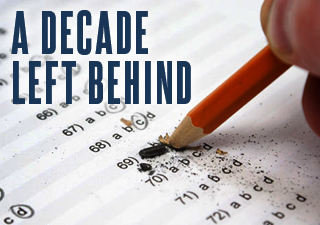Commentary

A Decade Left Behind
My first career started a few decades ago in the classroom as a high school history teacher. While much has changed since then – including the use of technology and smaller class sizes – the one constant is the need for “reform” to improve our education system.
Ten years ago, politicians from the Left and Right embraced “landmark” legislation that was supposed to fix everything wrong with American education. President George W. Bush, with the help of Sen. Ted Kennedy, passed the “No Child Left Behind Act” into law on January 8, 2002, setting the lofty goal of having all children reach proficiency in math and reading by the year 2014. It is clear we will fall far short of this goal.
Despite the best intentions of No Child Left Behind (NCLB), over 80,000 children in Pennsylvania attend violent and failing schools where fewer than 40 percent of the students are at grade level in these subjects. According to the National Assessment of Education Progress, four out of every five students in Philadelphia public schools are not proficient, and a significant racial achievement gap persists in Pennsylvania. NCLB was supposed to fix these problems. So why did it fail?
NCLB embodied two ideas for reforming education – changing the rules and increasing the resources. Standardized tests and academic proficiency standards were implemented. But these rule-based reforms have failed to deliver the promised improvements in education.
It’s not for lack of resources either. Pennsylvania increased education spending by 56 percent in the No Child Left Behind era. But again, there has been little to show for our investment: SAT scores have stagnated, state PSSA test exams show only minor gains, and NAEP scores have changed little.
The state of education in Pennsylvania is a state of emergency because rules and resource-based reforms fail to answer a very basic question: Why do we see a relentless drive for continuous quality improvement in nearly every other sector of our economy except public education?
The answer is incentives. We don’t see the kinds of improvement we expect because our public schools lack the necessary incentives. The late Al Shanker, former president of the American Federation of Teachers, summarized this best when he said: “It’s time to admit that public education operates like a planned economy, a bureaucratic system in which everybody’s role is spelled out in advance and there are few incentives for innovation and productivity.” Shanker added, “It’s no surprise that our school system doesn’t improve: It more resembles the communist economy than our own market economy.”
Shanker understood what Harrisburg has not. We need incentive-based reform to spur schools towards innovation and excellence. When schools compete, they must respond to parents making choices, or they risk going out of business.
In the marketplace, companies don’t improve simply because investors pour in money or the executives aim for high standards. If companies don’t improve, a competitor will come up with a better way to serve their customers and take their business. In this scenario, it is the customer who wins, not the underperforming company. The opposite holds true in Pennsylvania schools. Without the right incentives, the most important customers – our children – lose.
How do we know competition in education works? Here’s one example: School vouchers allow students to take public tax dollars we already spend on them to the school of their choice. Not only do such programs improve the learning of students who may come from failing public schools, but 18 of 19 studies show that vouchers also improve public school performance.
It is clear that schools do respond to competition. In Pennsylvania, family demand for spots in cyber schools has skyrocketed, with enrollment exploding from zero students a decade ago to nearly 28,000 today. In response, several school districts now offer their own online learning programs. Cyber schools, charter schools and scholarships funded by businesses are restoring opportunity and a future for children once left behind.
Instead of a one-size-fits-all system of education, we need to fully embrace an education marketplace where choice and competition is the rule rather than the exception.
Ten years of good intentions – with more rules and greater resources – have failed to dramatically improve our public school system. Only when we empower parents to choose the best school for their children will we truly give them greater opportunities rather than just good intentions.
# # #
Matthew J. Brouillette is the president and CEO of the Commonwealth Foundation (www.commonwealthfoundation.org), Pennsylvania’s free-market think tank.